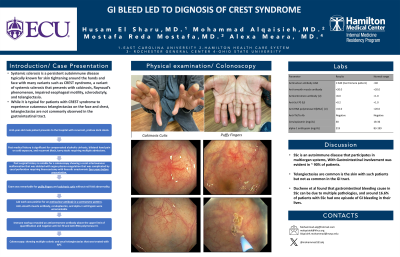Monday Poster Session
Category: GI Bleeding
P2102 - GI Bleed Leading to Diagnosis of CREST Syndrome
Monday, October 23, 2023
10:30 AM - 4:15 PM PT
Location: Exhibit Hall

Has Audio
- MA
Mohammad Alqaisieh, MD
Hamilton Medical Center
Dalton, GA
Presenting Author(s)
Husam El Sharu, MD1, Mohammad Alqaisieh, MD2, Mostafa Reda Mostafa, MD3, Alexa Meara, MD4
1East Carolina University, Greenville, NC; 2Hamilton Medical Center, Dalton, GA; 3Rochester Regional Health, Rochester, NY; 4The Ohio State University, Columbus, OH
Introduction: Systemic sclerosis is a persistent autoimmune disease typically known for skin tightening around the hands and face with many variants such as CREST syndrome, a variant of systemic sclerosis that presents with calcinosis, Raynaud’s phenomenon, impaired esophageal motility, sclerodactyly, and telangiectasia. While it is typical for patients with CREST syndrome to experience cutaneous telangiectasias on the face and chest, telangiectasias are not commonly observed in the gastrointestinal tract. Herein, we describe a patient with a gastrointestinal bleed who exhibited typical signs of CREST with cecal telangiectasia.
Case Description/Methods: A 61-year-old male patient presents to the hospital with recurrent, profuse dark stools. Past medical history is significant for compensated alcoholic cirrhosis, bilateral hand pain on cold exposure, and recurrent black, tarry stools requiring multiple admissions. Past surgical history is notable for a colonoscopy showing a cecal arteriovenous malformation that was ablated with Argon plasma coagulation that was complicated by cecal perforation requiring ileocecectomy with ileocolic anastomosis four years before presentation. Admission physical exam was remarkable for puffy fingers and calcinosis cutis without nail fold abnormality. Following adequate resuscitation, subsequent upper and lower endoscopy was performed, revealing the presence of two sessile adenomatous polyps that were removed. While investigating the causes of cirrhosis, Lab work was positive for an antinuclear antibody with a titer of 1:640 in a centromere pattern. Anti-smooth muscle antibody, ceruloplasmin, and alpha-1 antitrypsin were unremarkable (Table). Immune workup revealed an anticentromere antibody above the upper limit of quantification and negative anti-Scl-70 and Anti-RNA polymerase III.
Discussion: Despite right hemicolectomy, the patient exhibits Raynaud's phenomenon, calcinosis cutis, puffy fingers, cecal telangiectasia, and recurring dark, tarry stools. Based on the 2013 ACR/EULAR criteria for systemic sclerosis, our patient's score of 13 points confirms his definite diagnosis of systemic sclerosis. Although limited systemic sclerosis commonly affects the GI tract, bleeding is rarely described as the presenting symptom.

Disclosures:
Husam El Sharu, MD1, Mohammad Alqaisieh, MD2, Mostafa Reda Mostafa, MD3, Alexa Meara, MD4. P2102 - GI Bleed Leading to Diagnosis of CREST Syndrome, ACG 2023 Annual Scientific Meeting Abstracts. Vancouver, BC, Canada: American College of Gastroenterology.
1East Carolina University, Greenville, NC; 2Hamilton Medical Center, Dalton, GA; 3Rochester Regional Health, Rochester, NY; 4The Ohio State University, Columbus, OH
Introduction: Systemic sclerosis is a persistent autoimmune disease typically known for skin tightening around the hands and face with many variants such as CREST syndrome, a variant of systemic sclerosis that presents with calcinosis, Raynaud’s phenomenon, impaired esophageal motility, sclerodactyly, and telangiectasia. While it is typical for patients with CREST syndrome to experience cutaneous telangiectasias on the face and chest, telangiectasias are not commonly observed in the gastrointestinal tract. Herein, we describe a patient with a gastrointestinal bleed who exhibited typical signs of CREST with cecal telangiectasia.
Case Description/Methods: A 61-year-old male patient presents to the hospital with recurrent, profuse dark stools. Past medical history is significant for compensated alcoholic cirrhosis, bilateral hand pain on cold exposure, and recurrent black, tarry stools requiring multiple admissions. Past surgical history is notable for a colonoscopy showing a cecal arteriovenous malformation that was ablated with Argon plasma coagulation that was complicated by cecal perforation requiring ileocecectomy with ileocolic anastomosis four years before presentation. Admission physical exam was remarkable for puffy fingers and calcinosis cutis without nail fold abnormality. Following adequate resuscitation, subsequent upper and lower endoscopy was performed, revealing the presence of two sessile adenomatous polyps that were removed. While investigating the causes of cirrhosis, Lab work was positive for an antinuclear antibody with a titer of 1:640 in a centromere pattern. Anti-smooth muscle antibody, ceruloplasmin, and alpha-1 antitrypsin were unremarkable (Table). Immune workup revealed an anticentromere antibody above the upper limit of quantification and negative anti-Scl-70 and Anti-RNA polymerase III.
Discussion: Despite right hemicolectomy, the patient exhibits Raynaud's phenomenon, calcinosis cutis, puffy fingers, cecal telangiectasia, and recurring dark, tarry stools. Based on the 2013 ACR/EULAR criteria for systemic sclerosis, our patient's score of 13 points confirms his definite diagnosis of systemic sclerosis. Although limited systemic sclerosis commonly affects the GI tract, bleeding is rarely described as the presenting symptom.

Figure: Findings
Disclosures:
Husam El Sharu indicated no relevant financial relationships.
Mohammad Alqaisieh indicated no relevant financial relationships.
Mostafa Reda Mostafa indicated no relevant financial relationships.
Alexa Meara indicated no relevant financial relationships.
Husam El Sharu, MD1, Mohammad Alqaisieh, MD2, Mostafa Reda Mostafa, MD3, Alexa Meara, MD4. P2102 - GI Bleed Leading to Diagnosis of CREST Syndrome, ACG 2023 Annual Scientific Meeting Abstracts. Vancouver, BC, Canada: American College of Gastroenterology.
